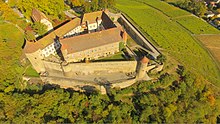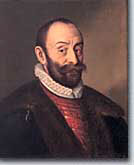Stettenfels Castle
| Stettenfels Castle | ||
|---|---|---|
|
Stettenfels Castle |
||
| Creation time : | around 1000 to 1100 | |
| Castle type : | Hilltop castle | |
| Conservation status: | Received or received substantial parts | |
| Place: | Untergruppenbach | |
| Geographical location | 49 ° 5 '22 " N , 9 ° 16' 54" E | |
|
|
||
The castle Stettenfels over the village Untergruppenbach in the district of Heilbronn is since the Middle Ages existing hilltop castle and palace complex , which is used for cultural events today.
history
The castle was built in the 11th century. It is believed that they were built at the same time as many other castles nearby. She changed hands frequently at an early stage. From 1356 Stettenfels was owned by Burkhard, a knight of Sturmfeder . From 1462 to 1478 the lords of Helmstatt owned the castle. When the Wuerttemberg ( Duke Ulrich ) conquered the castle in the War of Landshut in 1504 , the castle came into their possession and in 1507 became a fiefdom of the Wuerttemberg Hereditary Marshal Konrad Thumb von Neuburg . His son Hans Konrad Thumb von Neuburg sold the fiefdom in 1527 to Philipp von Hirnheim , who is considered to be the reformer of Gruppenbach.
In 1551 Anton Fugger , a nephew of Jacob the Rich , bought the castle. His son Hans Fugger had the complex converted into a renaissance palace by the builder Wendel Dietrich in 1576 . The castle burned down in 1594, but was again restored by Dietrich. In the 18th century the Fuggers tried to found a Capuchin hospice, but these buildings were destroyed by Württemberg in 1735. In 1747, Duke Karl von Württemberg acquired the facility, in 1829 the municipality of Gruppenbach acquired the property and retained rights of use in the event of later sales. In the 18th, 19th and 20th centuries, renovations took place continuously. In 1852 the red tanner Friedrich Korn from Calw acquired the property, in 1858 the Hamburg merchant Anton Mayer, and in 1881 the landlord Friedrich Bürkle. Until 1888 the complex housed the state forestry office, in the same year the Weinsberg farmer Christian Hildt acquired the castle.
In 1901 the Cologne lawyer Dr. Walter Putsch took over the facility and renovated the building in a contemporary style. In 1918 the Haldenwang family bought the property. In 1924 the shoe manufacturer Siegfried Levi from Kornwestheim acquired the facility in which he set up a stud . On October 5, 1937, Siegfried Levi was forced to “give away” Stettenfels Castle to the city of Heilbronn as part of the “ Aryanization ” process. Siegfried Levi escaped the Holocaust with his family by emigrating to South Africa. In 1939 the old bailiwick (1576) was rebuilt and parts of the complex demolished in order to build an "Ordensburg" of the NSDAP, which could no longer be realized due to the war.
After the Second World War, the facility was initially under American asset management. From 1946 the Protestant church operated a leisure and retirement home at the castle. In 1951 the castle came to the widow of Siegfried Levi through a reparation procedure, who sold the castle to Friedrich Spieser in 1957 , from whose heirs the complex was passed on to the Fleiner architect Roland Weimar in 1994.
Todays use
The castle is open to the public and managed. Concerts and theater events take place at the castle on behalf of the community. The private owners rent the castle complex, for example for large receptions, and there is a permanent beer garden in the castle garden, which can be used by visitors. Adjacent there are diverse agricultural uses, the slopes of the Stettenfels are used as vineyards and the plateau for a stud farm.
Since 2005 there has been a medieval castle festival with knight tournaments, jugglers, music and craftsmen at the castle every year. The festival has been taking place on May 1st and the following weekend since 2007 and now has several hundred participants and thousands of visitors.
investment
Stettenfels Castle is east of the historic town center on a sandstone step . The castle is surrounded by a wide moat with three old defense towers . The castle is accessed via a massive bridge through a gatehouse into the inner courtyard, which is triangularly enclosed by the various residential buildings of the castle. There is a fountain in the courtyard . The moat is accessible and a fortified stage has recently been set up for events.
The historic stair tower in the inner courtyard is striking . Although most of the castle's buildings date back to the Renaissance palace, its current appearance is shaped by renovation measures in recent years. Until well into the 20th century, a half-timbered gallery was added to the outer facade of a residential building and the stair tower . The former archways of the utility rooms on the ground floors are now largely walled up.
To the east of the actual castle complex, beyond the moat, there is a historic farm building, as well as some modern restaurant buildings.
Individual evidence
- ↑ Irmgard Sedler, Martin Burkhardt: In the sign of SALAMANDER: A company history in personal testimonials . Kohlhammer, Stuttgart 2014, ISBN 978-3-17-022511-4 , pp. 408 .
- ^ Friedrich Eisenmann: Siegfried Levi as lord of the castle at Stettenfels Castle. Retrieved on September 17, 2019 (German).
- ^ Website of the festival
literature
- Julius Fekete: Art and cultural monuments in the city and district of Heilbronn . Theiss-Verlag, Stuttgart 1991, ISBN 3-8062-0556-6 .
Web links
- Stettenfels Castle at burg-stettenfels.de










